 |
Medium Energy Physics Group
The Medium Energy Physics group at MSU is engaged in experiments that test our understanding of the structure of hadrons and experiments that search for violations of fundamental symmetries that serve as high precision tests of the Standard Model.
![[MSU Physics Logo]](http://dd285.physics.msstate.edu/files/mep_2011.jpg) |
The major thrusts of our program are:
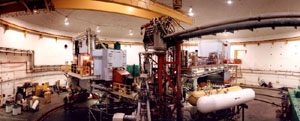
-
Search for signatures of Quantum Chromo Dynamics (QCD) in
nucleons and nuclei. QCD is the fundamental theory of the strong force and it
has been tested extremely well in the very high energy regime, i.e., the
perturbative QCD (pQCD) regime, but little is known in the non-perturbative
regime where ordinary matter exists. One of the important motivations of this
area of research is to understand the transition from the nucleon-meson to the quark-gluon degrees of freedom. Most of this research is carried out at Jefferson Lab (JLab) in Newport News. In these experiments both polarized and
unpolarized observables in exclusive processes are studied in search of
signatures of QCD such as color transparency, scaling, hadron helicity conservation, nuclear filtering and hidden color states. Here is a list of the most
recent experiments and proposals.
- High Precision Measurement of the Proton Charge Radius (PRad) (proposal).
- Color Transparency at 12 GeV (proposal).
- Charge Symmetry violating Quark Distributions (proposal).
- A GEM based active collimator for the SHMS spectrometer (progress)
------------------------------------------------------------------------------------------------------------------------
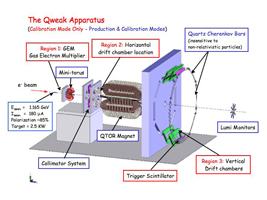 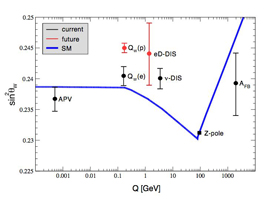
-
High precision tests of the Standard Model (SM) and search for "New Physics" beyond the SM. The SM is a mathematically consistent quantum field theory known
as the Standard Model, which predicts or is consistent with all known aspects
of the elementary particles and their interactions over an impressive range
of probes and scales. The MEP group is an integral part of the QWeak
experiment at JLab which will use parity violating electron scattering from
the proton to perform a high precision measurement of th weak charge of the proton.
- The QWeak Experiment (JLab site)
- The high power cryogenic hydrogen target for QWeak
- The recoil electron detector for the Hall C Compton polarimeter
- Development of a spin-light polarimeter for parity violating electron scattering experiments at 12 GeV.
------------------------------------------------------------------------------------------------------------------------
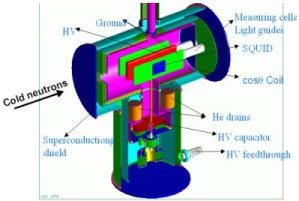
-
High precision tests of Time Reversal Invariance and search for "New Physics" beyond the SM. The MEP group is also part of the nEDM experiment which is a new search for a non-zero neutron electric dipole moment. This experiment proposed for the brand new Spallation Neutron Source at the Oak Ridge National Lab has a goal of factor of 100 improvement in the current experimental limit. This experiment offers an unique opportunity to measure a non-zero value of the neutron EDM, which would imply new sources of CP violation in nature that go beyond the mechanism in the SM. New sources of CP violation have profound implications for understanding the
preponderance of matter over antimatter in the universe (Baryon Asymmetry of the Universe).
- The nEDM experiment (LANL site)
- Measurement of polarized 3He relaxation at 0.5~K under the nEDM experimental condition. (In collaboration with the Duke MEP group).
- Measurement of polarized 3He injection into the experimental volume. (In collaboration with Duke MEP group).
- Simulation of the transport, injection and relaxation of polarized 3He in the experimental volume (in collaboration with BU, Maryland, Duke, Illinois, and Kentucky).
Mississippi State University * Physics & Astronomy
|
![[MSU Physics Logo]](http://dd285.physics.msstate.edu/files/Satellite.jpg)
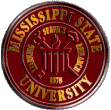
![[MSU Physics Logo]](http://dd285.physics.msstate.edu/files/Satellite.jpg)

